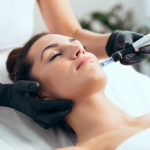Photo By aslysun at shutter stock
Do you suffer from a painful or irritating skin condition? Are you looking for an effective treatment that can help with acne? If you have any type of skin condition, you can visit a dermatologist who will make a diagnosis and prescribe a course of treatment to clear up your skin effectively.
This article will look at some of the most common skin conditions and give details of how a dermatologist may be able to help. If you’re searching for a professional in Southlake, TX or the surrounding area, don’t hesitate to contact Compassion Dermatology for an appointment today. The clinic treats a wide range of skin conditions.
Acne
Acne is the number one reason people visit a dermatologist because it is prevalent across America and the rest of the world. Acne is a condition that’s generally associated with teenagers. However, many of the patients seeking treatment from a dermatologist are adults. Acne is usually a long-lasting condition that can have significant effects on the patient’s body image, confidence, and self-esteem. It’s therefore a good idea to get the condition treated as soon as possible.
Most acne sufferers have spots on their faces as well as their chest, neck, upper back, and shoulders. Acne comes in different forms; some people have pimples. Other people have breakouts of whiteheads or blackheads. In other patients, painful nodules and even cysts develop. If acne is left untreated, it can leave scarring or darker spots on the skin.
Hives
Hives are a painful and irritating condition where raised, red, lumps develop on the skin, which are itchy. Hives can be caused by several different things, most commonly insect stings, some medication, or a food allergy. The good news is that hives will usually disappear on their own accord, and this usually takes just 2-4 hours.
For some unlucky people, hives will take months to clear up and may need treatment. If you have lots of hives all over your body or if you feel that your breathings are being affected, you should seek advice from a dermatologist as soon as possible.
The best way to get rid of hives is to avoid things that you think are triggering them. In some cases, there is no known cause for the hives, and a dermatologist will be able to prescribe medication to stop them from feeling itchy.
Sunburn
It’s incredible the number of people who seek help from a dermatologist for sunburn. It’s always better to prevent sunburn from occurring rather than to cure it. Sometimes it can be hard to know how much sun is safe or how long to spend on a UV bed.
Always put on sunscreen when out in the sun to protect your skin and stay in the shade during the hottest part of the day. Burns can be relieved using oil-free moisturizer. For more severe burns, a professional can prescribe a cream that contains iodine as well as anti-inflammatory drugs to help reduce pain and swelling.
Rosacea
Rosacea is a disease that causes swelling to patients’ faces, which is red and painful. There are often prominent blood vessels and pimples. The condition usually develops in females who are over thirty years old. Rosacea is caused by environmental elements or problems with the veins. Immune issues can also trigger it.
Eczema
Eczema is a common condition in children, but some adults have it as well. Its often not known what causes the disease, but the immune system, genetics, or the environment are all thought to play a part.
Eczema is usually in the skin fold of joints but can also be on the face, feet, and hands. The condition can be flaky and dry with skin that looks red and is itchy. Doctors often use steroids to get rid of the condition, but a dermatologist will be able to prescribe creams that can be used long term.
Herpes
Herpes is caused by the same virus that causes chickenpox and symptoms of the condition include red, blistered skin that can appear anywhere on the body. Herpes may also be accompanied by other problems such as a headache, fever, or fatigue.
Athlete’s Foot
Athletes’ foot is a common fungal infection that causes redness and itching between the toes. It can also cause cracked skin. Athletes’ foot is often caught from public places, including showers, swimming pools, and gym locker rooms. A dermatologist is likely to provide antifungal treatments.
Psoriasis
Psoriasis is a widespread skin condition that affects about 6.7 million people in America. Psoriasis causes painful scaly patches that look red or silver. The condition also causes bone stiffness as well as swelling or pain in the joints.
Applying a moisturizing cream to the affected areas will help psoriasis as this will stop the skin from drying out. You’ll likely be prescribed cortisone cream if you have psoriasis.
Warts
Warts are caused by the human papillomavirus and are raised bumps that can be anywhere on the body. There are five different types of warts, and most of these will need to be removed by being frozen off using salicylic acid. Warts usually aren’t dangerous, but they are contagious and look unsightly, they can also be painful.
Compassion Dermatology
If you suffer from any of the above skin conditions and are looking for help, advice, and treatment, don’t hesitate to contact Compassion Dermatology. The clinic serves Southlake, TX, and the surrounding area.
Compassion Dermatology is a place where your skin can heal; the skilled medical team will help you improve your skin’s overall health. The practice comprises expert medical, surgical, and cosmetic doctors who provide services for skin, hair, and nails.
The skilled skin-care team is highly experienced and remains up-to-date with the latest treatments, research, and technologies. If you’re looking to improve your skin appearance or reduce irritating symptoms, contact Compassion Dermatology today on 817-893-2670.


